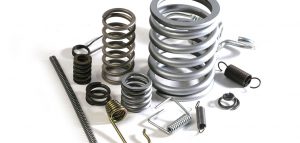Designing a custom wire form requires balancing performance, cost-efficiency, and manufacturability. In this guide, we’ll cover key elements of wire form design—from selecting the right material to applying Design for Manufacturability (DFM) principles—ensuring your project moves smoothly from prototype to production.
Whether you’re developing wire forms for medical devices, electrical switchgear, or industrial equipment, these tips will help you design components that meet your application demands while supporting efficient production.
Material choice directly affects strength, fatigue resistance, corrosion protection, and cost. In custom wire form manufacturing, common materials include:
Carbon Steel
A versatile and affordable option, carbon steel is well-suited for general-purpose wire forms used in industrial applications. While it doesn’t offer the corrosion resistance of stainless steel, protective finishes can be applied to increase durability.
Stainless Steel
Ideal for medical wire forms, surgical tools, IV bag hook assemblies, and medical case handles. Stainless steel grades like 302 and 316 resist corrosion, allow for easy sterilization, and perform reliably in demanding environments.
Music Wire
High-tensile, high-carbon spring steel like music wire is ideal for spring wire forms that require precise force retention and fatigue resistance. Common uses include clips, retainers, and snap-fit components where repetitive motion is expected.
Tip: Evaluate your application’s environment, including moisture, chemicals, and temperature, when selecting material and finishing processes to ensure your wire form maintains performance over time.

Tolerances affect both part function and cost. Setting tolerances appropriate to your application is key:
For prototypes or small batches, wider tolerances may help reduce costs and simplify tooling.
For production wire forms, especially those used in automated assemblies or power generation equipment, tighter tolerances ensure consistency and fit.
Remember that tighter tolerances increase production complexity and inspection time, potentially raising costs.
Finishes serve both protective and functional roles in wire form manufacturing. Common options include:
Choose finishes based on both visual and functional needs. For instance, IV bag hook wire forms or surgical case handles benefit from corrosion-resistant passivation for sterilization and hygiene.
Incorporating DFM into your wire form design ensures efficient production:
Consider a medical device component requiring a custom wire form. An initial design may specify sharp bends and a specialty alloy. Working with a manufacturer might reveal:
Successful wire form engineering balances mechanical needs with manufacturability. Choosing the right materials, setting proper tolerances, applying suitable finishes, and following DFM principles allows engineers to create wire forms that are durable, practical, and optimized for production.
At Ace Wire Spring & Form Co., Inc., we specialize in custom wire forms manufactured in the USA. From IV bag hooks and medical case handles to wire forms for high-voltage switchgear and circuit breakers, we provide engineering guidance to help you refine your design and deliver high-performance components.
Contact Ace Wire Spring & Form Co., Inc. for expert engineering support, design assistance, and a custom quote today.
Copyright © Ace WIre Spring & Form Company, Inc. All Rights Reserved. Pittsburgh Website Design by Higher Images.